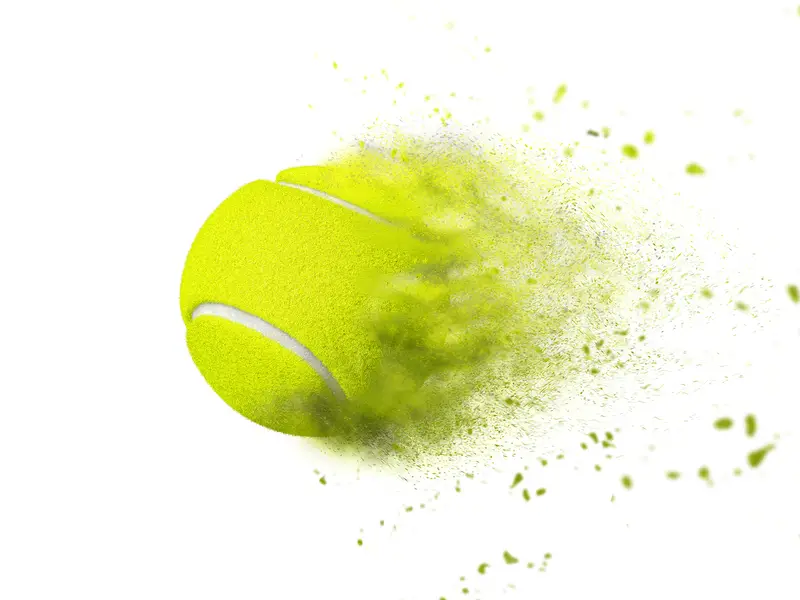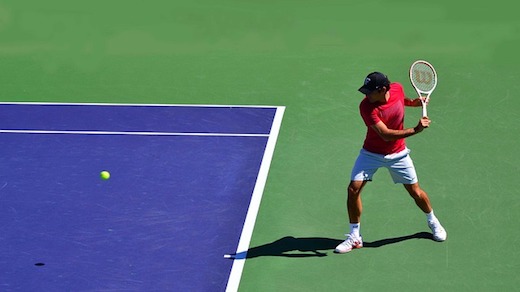- Durability because the more fuzz on the ball, the longer the ball will last.
- Court Responsiveness as the fuzz helps to absorb the impact on the surface
- Spectator viewing
- Avoid dull reaction feeling off your tennis racket string.
Your Guide
 Gavin Davison
Gavin Davison
Have you ever stopped and marveled at a tennis ball?
Okay, you might not look at one the same way you might look at a celebrity or some athletic SUPERSTAR, but they’re still pretty cool.

I often wonder about the actual manufacturing process of tennis balls, and how people ultimately decided to follow the structure that tennis balls have today.
Tennis balls actually have a really interesting history, moving from just a rubber sphere, which was white, to the bright and vibrant balls we see today. But one question has always bugged me, as it may have you as well.
Why are tennis balls fuzzy?
After all, footballs aren’t fuzzy
Cricket balls aren’t fuzzy
Rugby balls aren’t fuzzy – you get the idea!
Having done my research, I found some INTERESTING answers that I’d like to share with you.
4 Main reasons for the fuzz
1) Durability
I must admit, I’ve had this in the back of my mind prior to writing the piece, but research confirmed my suspicions.
One of the top reasons behind the outer FUZZ on tennis balls is durability.
The more fuzz on the ball, the longer the ball will last, in theory.
That’s why I love playing with Slazenger Wimbledon tennis balls, as they are super fuzzy, have a great feel to them, and they last forever!
Other balls, not that I will throw any brand under the bus, do not achieve the same results – mainly because they are less fuzzy.
2) Court Responsiveness
One of the main objectives of brands that supply tennis balls is to make them as RESPONSIVE as possible.
In short, if the balls didn’t react well off the court surface, rallies wouldn’t last very long, and the game of tennis certainly wouldn’t be much fun to watch or play.
The outer layer of the fuzz is one of the secret weapons behind this, as the fuzz helps to absorb the impact on the surface, and it provides a bit of a ‘spring effect’.
Of course, this is helped by the pressure and rubber sole of the ball too, but the fuzz does play its part.
3) Spectator Viewing
I must admit, this was one of the most interesting things I found when conducting my research.
If you watch any tennis games up until 1972, you will see that the ball is actually WHITE.
Since the 70s were also a time where important tennis matches started to be broadly televised, a complaint started to file through – ‘WE CAN’T SEE THE BALL!
Believe it or not, fans who were watching the game on TV, and in the stands too, were influential in the color change to the yellow ball we see today.
Some clever manufacturers quickly figured out that rather than changing the entire process of making a tennis ball, they would simply add some YELLOW FUZZ.
This allowed the mass production of tennis balls to continue, without any form of delay, and spectators all around the world became much happier.
4) Reaction off the Strings
If you were to strike a tennis ball that didn’t have any kind of fuzz on it, the feel would be rather dull.
After all, if you PEEL away the felt, or the fuzz, you are simply left with a hollow, rubber ball.
Now, given that tennis strings have evolved to such a point where strings are now hexagonal, among other shapes to grip the ball, if a ball had no fuzz this would make the technological improvements null and void.
So, when you get a nice bit of fuzz on a ball, this actually helps by gripping the strings, sinking into them as the ball then CATAPULTS down the other side of the court.
The less fuzzy balls definitely don’t have this kind of feel.
I can even remember playing tournaments as a junior where the organizers had chosen to purchase cheap, non-fuzzy balls for the event.
Sometimes it would be a struggle just to keep the ball in the court, and that’s because you couldn’t easily place a spin on the ball due to the lack of responsiveness.
Differences in tennis balls
Clay Court
Up until 2020, the most prestigious clay-court event of the year, Roland Garros, used Babolat balls.
These balls were ideal as they had less fuzz for a greater response off the court, creating a chance for players to have longer RALLIES and play real clay-court tennis.
In the 2020 event, Roland Garros switched to Wilson balls, much to the annoyance of Rafael Nadal.
These balls were reportedly heavier, as well as less fuzzy, but besides the players’ opinions, clay court balls are always designed to have a thinner layer of fuzz.
Hard Court
Hardcourt tennis is the most common form of the game, and the balls you can use vary quite WIDELY for such play.
Since hard courts naturally react quite well to the ball, there is no need for balls to have reduced fuzz, otherwise, the court would be too LIVELY.
Then again, you don’t want a ball that is overloaded in fuzz, as then play would be too slow.
That’s why the Wilson US Open ball is perfect for hard court tennis, and this is actually the ball we used to play within NCAA tennis – which was solely hard court!
Grass Court
The grass-court season is incredibly short, with just a few weeks of action each year.
And since grass courts are by far the least responsive of all tennis surfaces, the balls need that EXTRA layer of fuzz to get some bounce going on.
Sure, the greats of the grass game still try to overcome this by hitting flat through the court, but without this extra fuzz, I’m not even sure that grass-court tennis would exist – not at the highest level anyway.
Without the fuzz, I don’t believe that the quality of rallies would be as good, watching the game wouldn’t be as easy or enjoyable, and if you wanted to speculate a bit – the sport wouldn’t be what we know it as today.
Has this information answered your question? Are you feeling more knowledgeable about the purpose of fuzz on tennis balls? Let us all know down below.



